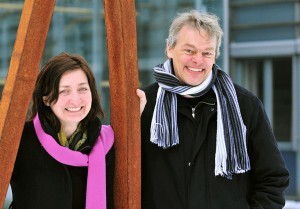British-American John O’Keefe and Norwegians May-Britt and Edvard Moser won the 2014 Nobel Prize for medicine for discovering the brain’s navigation system and giving clues as to how strokes and Alzheimer’s disrupt it. All worked on different components of the same problem: how we ‘orient ourselves in space’ and navigate. The Nobel Assembly, at Sweden’s Karolinska Institute said the discovery solved a problem that had occupied philosophers and scientists for centuries: ‘How does the brain create a map of the space surrounding us and how can we navigate our way through a complex environment?’
O’Keefe was honoured for finding a type of nerve cell in the brain area called ‘place’ cells. Born in New York City to Irish immigrant parents, O’Keefe attended Regis High School (Manhattan) and received a bachelor’s degree from the City College of New York. He originally went to University College London in 1967 as a US NIMH postdoctoral fellow and has been there ever since, and was awarded a professorship in 1987. These cells were first discovered in the hippocampus of the brain in 1971 by Keefe and Dostrovsky1,2. O’Keefe postulated in 1976 that these cells activated themselves according to where a rat located itself in a room3.
Though the hippocampus plays a role in learning and memory, the existence of place cells within the hippocampus demonstrates the role it plays with spatial adaptation and awareness. There have been recorded increases in firing patterns of rats in open environments and recorded spatial learning and awareness impairments after damage to the hippocampus and the place cells within. Studies with rats showed that place cells are very responsive to spatial surroundings3.
He went on to study for his doctoral degree in physiological psychology with Ronald Melzack in Donald O. Hebb’s department at McGill University in Montreal.
O’Keefe concluded that these ‘place cells’ formed a map of the room. A place cell is a type of pyramidal neuron within the hippocampus that becomes active when the animal enters a particular place in the environment; this place is known as the place field. A given place cell will have only one, or a few, place fields in a typical small laboratory environment, but more in a larger region. The place cells are thought, collectively, to act as a cognitive representation of a specific location in space, known as a cognitive map. Place cells work with other types of neurons in the hippocampus and surrounding regions to perform this kind of spatial processing.
Studies with rats have shown that place cells tend to fire quickly when a rat enters a new, open environment, however outside of a firing field, place cells tend to be relatively inactive. Together place cells are thought to form a ‘cognitive map’ in which they have localised firing patterns called place fields. Place cell firing patterns are often determined by external sensory information and the local environment4. Place cells have proven to have the ability to suddenly change their firing pattern from one pattern to another, a phenomenon known as ‘re-mapping’ and though place cells do change according to the external environment, they are stabilized by attractor dynamics which ‘enable the system to resist small changes in sensory input but respond collectively and coherently to large ones’.5
Edvard Moser grew up in Ålesund, both his parents had immigrated to Norway from Germany in the 1950s. His mother was originally from Essen and his father from Kronberg im Taunus. He graduated with a psychology degree at the University of Oslo in 1990 and PhD in neurophysiology in 1995. He, along with his wife May-Britt Moser, are both psychologists, neuroscientists and founding directors of the Kavli Institute for Systems Neuroscience and Centre for the Biology of Memory at the Norwegian University of Science and Technology (NTNU) in Trondheim, Norway. The Mosers were appointed associate professors in psychology and neuroscience at NTNU in 1996, less than one year after their PhD submissions.
The scientific goal of the Kavli Institute is to advance understanding of neural circuits and systems by focusing on spatial representation and memory7. The Mosers also researched the general principles of neural network computation in the mammalian cortex by pioneering research on the brain’s mechanism for representing space. In 2005, they mapped differing connections in the hippocampus as rats moved about a room and discovered an astonishing pattern of activity in a nearby part of the brain called the entorhinal cortex. In this area, certain cells called ‘grid cells’ activated as the rats moved past locations in a hexagonal grid. The Mosers found that these comprised a system of coordinates that permitted spatial navigation.
Later research using brain imaging showed that the same system exists in humans. Patients with Alzheimer’s disease lose their way around because the particular areas of the brain are affected. The Nobel Committee said ‘the discovery of the brain’s positioning system represents a paradigm shift in our understanding of how ensembles of specialized cells work together to execute higher cognitive functions. It has opened new avenues for understanding other cognitive processes, such as memory, thinking and planning’.





